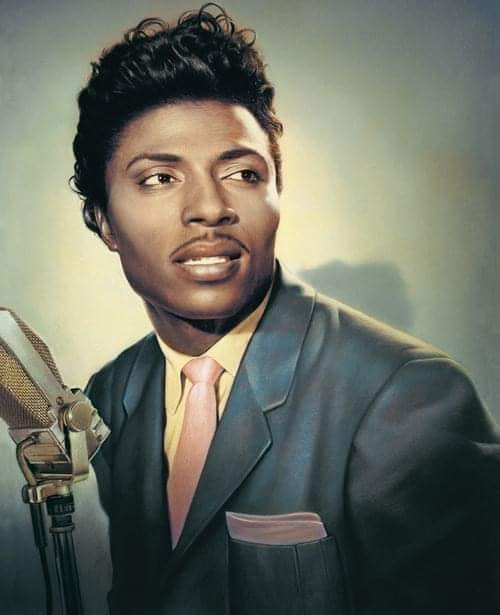Richard Wayne Penniman (born December 5, 1932 – May 9, 2020 it), known as Little Richard, is an American musician, singer, actor, comedian and songwriter and Rock and Roll Icon.An influential figure in popular music and culture for seven decades, Little Richard’s most celebrated work dates from the mid-1950s, when his dynamic music and charismatic showmanship laid the foundation for rock and roll. His music also played a key role in the formation of other popular music genres, including soul and funk. Little Richard influenced numerous singers and musicians across musical genres from rock to hip hop; his music helped shape rhythm and blues for generations to come, and his performances and headline-making thrust his career right into the mix of American popular music.Little Richard has been honored by many institutions. He was inducted into the Rock and Roll Hall of Fame as part of its first group of inductees in 1986. He was also inducted into the Songwriters Hall of Fame. He is the recipient of a Lifetime Achievement Award from the Recording Academy and a Lifetime Achievement Award from the Rhythm and Blues Foundation. Little Richard’s “Tutti Frutti” (1955) was included in the National Recording Registry of the Library of Congress in 2010, which stated that his “unique vocalizing over the irresistible beat announced a new era in music.” In 2015, the National Museum of African American Music honored Little Richard with a Rhapsody & Rhythm Award for his pivotal role in the formation of popular music genres and in helping to shatter the color line on the music charts, changing American culture significantly.Born Richard Wayne Penniman, he was one of 12 children born to Charles “Bud” Penniman, a Seventh Day Adventist preacher who sold moonshine on the side. Richard grew up in Macon, Georgia. Music was all over. Street vendors and evangelists would sing, selling everything from vegetables to religion. The neighborhood sang spiritual songs as they worked. Several gospel singers influenced Richard.Initially, Little Richard’s first name was supposed to have been “Ricardo” but an error resulted in “Richard” instead. The Penniman children were raised in a neighborhood of Macon called Pleasant Hill. In childhood, he was nicknamed “Lil’ Richard” by his family, because of his small and skinny frame. A mischievous child who played pranks on neighbors, Little Richard began singing in church at a young age. Possibly as a result of complications at birth, Little Richard had a slight deformity that left one of his legs shorter than the other. This produced an unusual gait; he was mocked for his allegedly effeminate appearance.As a kid, he sang gospel with the Penniman Singers and Tiny Tots Quartet. Richard had a hyperactive personality that made him popular, but also got him into trouble. His homosexuality didn’t help matters and he left home and danced to draw customers in a traveling medicine show. By age 15, he was a regular with Sugarfoot Sam’s Minstrel Show. At 18, he won a talent contest in Atlanta that led to a recording contract with RCA Victor. Four records were recorded that went nowhere. In 1955, Art Rupe of Hollywood-based Specialty Records got a demo tape from Richard. That same year, Richard came to J&M Studios in New Orleans for the first time. It was here that he recorded some of the greatest sides in rock and roll history with producer Bumps Blackwell.Later that year “Tutti-Frutti” crossed over from the R&B to the pop chart, rising to #17. This was followed by “Long Tall Sally” released on Specialty Records, topping the R&B chart for eight weeks and reaching #6 on the pop chart. Richard hit #2 on the R&B chart and #33 on the pop chart with “Slippin’ and Slidin’ (Peepin’ and Hidin’)” and #1 on the R&B chart and #17 on the pop chart with “Rip It Up.” In 1957, He hit #1 on the R&B chart and #21 on the pop chart with “Lucille,” #3 on the R&B chart with “Send Me Some Lovin’,” #2 on the R&B chart and #10 on the pop chart with “Jenny, Jenny” and #2 on the R&B chart and #8 on the pop chart with “Keep A Knockin’.”That same year Richard suddenly left rock and roll for religion. He entered Oakwood Theological College in Huntsville, Alabama. One year later he hit #4 on the R&B chart and #10 on the pop chart with the Specialty release “Good Golly, Miss Molly.” In 1959, the album “Little Richard Sings Gospel,” was issued on the 20th Century label. He recorded gospel in the coming years for the Mercury and Atlantic labels, working with such producers as Jerry Wexler and Quincy Jones.In 1970, he quit music at the height of his career to re-enter Oakwood theological college. He received a BA from the college and later became ordained as a Seventh Day Adventist minister. That same year Richard released “The Rill Thing,” the first of three albums. It was followed by “The King of Rock and Roll” and “The Second Coming.” The last of these reunited him with the core crew from his historic 1950s sessions in New Orleans. In 1977, Richard again walked away from rock and roll to embrace evangelical Christianity. He became a traveling Bible salesman and preacher following a period of drug and alcohol abuse. In 1979, he released the gospel album “God’s Beautiful City.”In 1986, Little Richard was inducted into the Rock and Roll Hall of Fame. That same year, he had a memorable role in the 1986 film “Down and Out in Beverly Hills.” In 1993, he received a Lifetime Achievement Award during the 35th annual Grammy Awards. One year later, Richard received a Lifetime Achievement Award from the Rhythm and Blues Foundation.In 2010, Time Magazine listed ‘Here’s Little Richard’ as the Number 2 of the 100 Greatest and Most Influential Album of All Time – the highest rock and roll album on the entire list. Included in numerous Rolling Stone lists, Little Richard’s Here’s Little Richard was ranked fifty on the magazine’s list of the 500 Greatest Albums of All Time. He was ranked eighth on its list of the 100 Greatest Artists of All Time. Rolling Stone listed three of Little Richard’s recordings, “The Girl Can’t Help It”, “Long Tall Sally” and “Tutti Frutti”, on their 500 Greatest Songs of All Time. Two of the latter songs and “Good Golly, Miss Molly” were listed on the Rock and Roll Hall of Fame’s 500 Songs that Shaped Rock and Roll. The Grammy Hall of Fame inducted several of Little Richard’s recordings including “Tutti Frutti”, “Lucille”, “Long Tall Sally” and Here’s Little Richard. In 2007, an eclectic panel of renowned recording artists voted “Tutti Frutti” number one on Mojo’s The Top 100 Records That Changed The World, hailing the recording as “the sound of the birth of rock and roll.” In April 2012, Rolling Stone magazine declared that the song “still has the most inspired rock lyric on record.” The same recording was inducted to the Library of Congress’ National Recording Registry in 2010, with the library claiming the “unique vocalizing over the irresistible beat announced a new era in music”.On May 9, 2020, Richard died at the age of 87 at his home in Tullahoma, Tennessee, from a cause related to bone cancer, after a two-month illness. His brother, sister, and son were with him at the time of his death. In the following days, Richard received tributes from many popular musicians, including Bob Dylan, Paul McCartney, Mick Jagger, John Fogerty, Elton John, and Lenny Kravitz, as well as many others, such as film director John Waters, who were influenced by Richard’s music and persona. He is interred at Oakwood University Memorial Gardens Cemetery in Huntsville, Alabama.
Written by Dianne Washington

